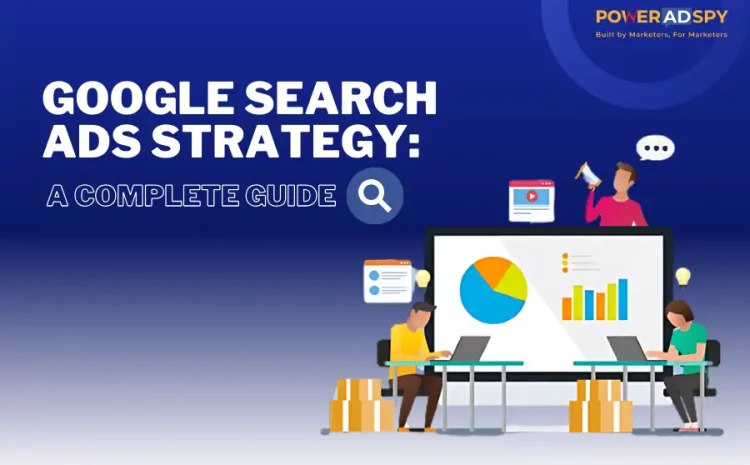Power Of Google Search Ads Strategy: A Complete Guide
Are you tired of playing hide-and-seek with your target audience? It’s time to step into the spotlight. With a killer search ads strategy, you can transform your business from a tiny seed into a towering oak.
Let’s dive deep into the world of Google Search Ads and unlock the secrets to skyrocketing your online visibility. Whether you’re a seasoned marketer or just starting, this guide will equip you with the knowledge and tools to create a search ads strategy that packs a punch.
Get ready to dominate the search engine results pages, attract qualified leads, and boost your bottom line. It isn’t just a guide; it’s your roadmap to search ads success.
Hit ‘Play’ Button & Tune Into The Blog!
Understanding Google Search Ads Strategy:
 Google Search Ads or pay-per-click (PPC) ads, are text-based advertisements that appear above or below organic search results on Google’s search engine results pages (SERPs). These ads are triggered by specific keywords chosen by advertisers, making them highly targeted and relevant to users’ search queries.
Google Search Ads or pay-per-click (PPC) ads, are text-based advertisements that appear above or below organic search results on Google’s search engine results pages (SERPs). These ads are triggered by specific keywords chosen by advertisers, making them highly targeted and relevant to users’ search queries.
Thorough keyword research is essential for an effective Google Search Ads strategy. By identifying the most relevant and high-performing keywords for your business, you can ensure that your ads reach the right audience at the right time, thus increasing the likelihood of conversions and maximizing your advertising budget.
How Google Search Ads Work:
Keyword Matching:
Google Search Ads operate on a keyword-matching system. Advertisers select keywords relevant to their business, and Google uses them to determine when and where their ads should appear. For example, if you sell running shoes and select the keyword “buy running shoes,” your ad may appear when someone searches for that term or related phrases.
Ad Auction:
Google uses an auction system to determine the placement of ads. When a user searches, Google runs an auction to decide which ads will appear and in what order. The auction considers various factors, including bid amount, ad relevance, and quality score.
Bid Amount:
Advertisers set a maximum bid amount for their keywords, which is what they are willing to pay for a click on their ad. However, the actual cost-per-click (CPC) can be lower, depending on the competition and quality of the ad.
Quality Score:
Google assigns a Quality Score to each ad based on its relevance to the user’s search, the quality of the landing page, and the expected click-through rate (CTR). A higher Quality Score can lower the cost of your ads and improve their placement.
Components of a Winning Google Ads Strategy:
 A winning Google ads strategy comprises several vital components. You can also consider these components as Google ads optimization tips to use:
A winning Google ads strategy comprises several vital components. You can also consider these components as Google ads optimization tips to use:
Ad Groups and Campaign Structure: Organize your campaigns and ad groups in a logical manner that mirrors your product categories or services. It ensures that your ads are relevant to the keywords and landing pages you’re targeting.
Bidding Strategies: Choose the right bidding strategy based on your campaign goals. Whether it’s maximizing clicks, conversions, or impression share, selecting the appropriate bidding method can significantly influence your campaign’s success.
Ad Copy and Creative: Create persuasive ad copy that emphasizes your unique selling points (USPs) and includes a compelling call-to-action (CTA). Ad creativity can significantly impact your click-through rate (CTR) and overall campaign performance.
Landing Page Optimization: Make sure your landing pages are optimized to convert. They should be relevant to your ad copy, load quickly, and provide a seamless user experience. A well-optimized landing page can drastically improve your conversion rates.
Performance Tracking and Analysis: Utilize Google Ads and Google Analytics to track the performance of your campaigns. Regularly analyze crucial metrics such as CTR, conversion rate, cost per conversion, and ROI to make data-driven decisions and optimize your strategy.
Google Search Ads Strategy: The Basics
 Pay-per-click (PPC) ads, also known as Google Search Ads, are text-based advertisements that appear at the top or bottom of Google’s search engine results pages (SERPs). Advertisers select specific keywords to trigger these ads, ensuring they are highly relevant and targeted to users’ search queries.
Pay-per-click (PPC) ads, also known as Google Search Ads, are text-based advertisements that appear at the top or bottom of Google’s search engine results pages (SERPs). Advertisers select specific keywords to trigger these ads, ensuring they are highly relevant and targeted to users’ search queries.
Proven Strategies for a Successful Google Search Ads Campaign:
Comprehensive Keyword Research
- Utilize Keyword Tools: Leverage tools like Google Keyword Planner, SEMrush, or Ahrefs to identify high-performing keywords with substantial search volume and manageable competition. These tools provide insights into keyword trends, search volume, and cost-per-click, aiding in creating an effective search ads strategy.
- Focus on Long-Tail Keywords: Incorporate specific, long-tail keywords into your approach. These are more specific phrases that often have lower competition and higher conversion rates. For example, “affordable running shoes for women” could be more effective than “running shoes.”
- Analyze Competitor Keywords: Use tools like PowerAdSpy to discover the keywords your competitors are targeting. It can reveal valuable opportunities to capture traffic that others are targeting but may be missing.
Crafting Compelling Ad Copy:
- Highlight Unique Selling Points (USPs): Highlight what differentiates your product or service. Whether it’s free shipping, a special discount, or a unique feature, make sure it’s clear in your ad copy.
- Incorporate Strong Calls-to-Action (CTAs): Use actionable language that motivates users to take the next step. Phrases like “Shop Now,” “Get Started Today,” or “Request a Quote” can drive higher click-through rates.
- Use Dynamic Keyword Insertion: This feature automatically updates your ad copy to include the user’s search query, making your ad more relevant and increasing the likelihood of a click.
Effective Ad Group and Campaign Structure:
- Organize by Themes: Structure your campaigns and ad groups around specific themes or product categories. This approach aids in developing highly relevant ads and landing pages, improving overall quality scores.
- Use Single Keyword Ad Groups (SKAGs): For highly competitive or important keywords, consider using SKAGs. It means having ad groups that target just one keyword to ensure maximum relevance and control over bidding and ad copy.
Optimizing Bidding Strategies:
- Leverage Automated Bidding: Use Google’s automated bidding strategies like Target CPA (Cost Per Acquisition) or Target ROAS (Return on Ad Spend) to optimize bids for conversions or revenue, respectively. These strategies use machine learning to adjust bids instantly based on performance data. Incorporating these techniques is one of the best practices for Google bid strategy.
- Monitor and Adjust Bids Regularly: Regularly review and adjust your bids based on performance metrics. Increase bids for high-performing keywords and reduce bids for those that are underperforming as part of your search ads strategy.
Enhancing Landing Page Performance:
- Ensure Relevance and Alignment: The landing page should closely align with your ad’s promise. For instance, if your ad promotes a discount on running shoes, the landing page should highlight that discount.
- Optimize for Speed and Mobile: A fast-loading, mobile-friendly landing page enhances user experience and can lead to higher conversion rates. Tools such as Google Page Speed Insights can assist in pinpointing and resolving performance problems.
- Implement Conversion Rate Optimization (CRO) Techniques: Use techniques such as A/B testing to find the most effective landing page elements. Test multiple headlines, images, CTAs, and forms to determine which combinations drive the most conversions.
Utilizing Ad Extensions:
- Incorporate All Available Extensions: Use site link extensions, call extensions, location extensions, and structured snippets to provide additional information and make your ads more engaging.
- Highlight Key Offers and Features: Use callouts and promotions to spotlight exclusive offers or unique features in your search ads strategy.
Regular Performance Tracking and Analysis:
- Monitor Key Metrics: Track essential metrics such as Click-Through Rate (CTR), Conversion Rate, Cost Per Conversion, and Return on Ad Spend (ROAS). Analyzing these metrics helps in understanding campaign performance and making data-driven decisions.
- Utilize Google Analytics: Integrate Google Analytics with your Google Ads account to gain deeper insights into user behavior and interactions on your site. It can inform your optimization strategies and enhance targeting.
Implementing Insights from Competitor Analysis:
- Analyze Competitor Ads: Use tools like PowerAdSpy to review your competitors’ successful ads. Understand their strategies, messaging, and keywords to refine your approach.
- Adapt to Industry Trends: Stay updated with industry trends and competitor strategies. Adapting to these trends helps you remain competitive and relevant in your market.
You can elevate your Google Search Ads performance by implementing these proven tactics and continuously refining your approach. You can also use PowerAdSpy to gain deeper insights into competitor ads and further enhance your search ads strategy.
Implementing PowerAdSpy Insights into Your Google Ads Strategy:
 PowerAdSpy is a sophisticated Google Ads spy tool that offers marketers detailed insights into their competitors’ advertising strategies. By leveraging PowerAdSpy, you can gain a competitive edge and refine your search ads strategy to achieve better results. Here are some of the key features and benefits of using PowerAdSpy:
PowerAdSpy is a sophisticated Google Ads spy tool that offers marketers detailed insights into their competitors’ advertising strategies. By leveraging PowerAdSpy, you can gain a competitive edge and refine your search ads strategy to achieve better results. Here are some of the key features and benefits of using PowerAdSpy:
Comprehensive Ad Analysis:
PowerAdSpy allows you to analyze your competitors’ ads in detail. You can view the ad copy, headlines, and call-to-actions used in their most successful ads. It provides insight into what is effective and what isn’t within your niche.
Keyword analysis:
With PowerAdSpy, you can uncover the keywords your competitors are bidding on. This feature assists you in identifying high-converting keywords that you might not have considered, enabling you to expand your keyword list and attract more qualified traffic.
Ad Performance Metrics:
It provides performance metrics for each ad, such as engagement rates. These insights help you gauge the effectiveness of different ad strategies and adapt your campaigns accordingly.
Competitor Tracking:
PowerAdSpy alerts you to new ads launched by your competitors, helping you stay updated on their latest strategies and adjust your campaigns to maintain a competitive edge.
Ad Trend Analysis:
Stay ahead of industry trends by analyzing the latest ad trends in your niche. PowerAdSpy provides data on trending ad formats, messaging, and visuals, enabling you to create ads that resonate with your target audience.
Ad Copy Inspiration:
Use it to gather inspiration for your ad copy. By reviewing successful ads in your industry, you can craft compelling and persuasive ad copy that captures attention and drives conversions.
Geo-Targeting Insights:
Understand where your competitors are targeting their ads geographically. This information helps you identify potential markets to explore and tailor your ad campaigns to specific regions for maximum impact.
Gain valuable insights into your competitors’ advertising strategies, revealing their top-performing ads, keywords, and targeting tactics.
Also Read:
7 Google Ads Optimization Tips to Boost Your ROI Now
5 Powerful Best Practices For Google Bid Strategy in 2024
Hotel Advertising: 9 Ultimate Tips And Tricks For Your Business
Why Google Ads Benchmarks Are A Huge Gift To Marketers
Conclusion
With the rise of digital marketing, mastering Google Ads is crucial for business success. A robust Google Ads strategy, encompassing thorough keyword research, compelling ad copy, effective bidding strategies, and optimized landing pages, can drive targeted traffic, generate leads, and boost sales.
Consistently tracking and analyzing performance, utilizing tools such as Google Analytics, guarantees data-based decisions that enhance your campaigns. Leveraging competitive insights from tools like PowerAdSpy offers a distinct advantage. By understanding your competitors’ strategies, you can identify high-performing keywords, uncover impactful ad placements, and stay ahead of industry trends.
The power of Google Ads lies in connecting businesses with their ideal customers at the right moment. Implementing the strategies and insights from this guide will maximize your ROI and enhance your search ads strategy. Embrace the power of Google Ads to transform your digital marketing efforts into a driving force for growth and success.
FAQs: –
1. What are the different types of Google Search Ads?
Google Search Ads include:
- Text Ads: Standard ads with a headline, description, and URL.
- Responsive Search Ads: Ads that automatically adjust headlines and descriptions for better performance.
- Call-Only Ads: Ads that focus on driving phone calls rather than website visits.
- Dynamic Search Ads: Ads generated automatically based on your website content and user queries.
2. What is the main benefit of using Google Search Ads?
Google Search Ads enable businesses to target potential customers actively searching for products or services similar to theirs, increasing the likelihood of conversions through a well-planned search ads strategy.
3. How can I find the best keywords for my Google Search Ads?
Use tools like Google Keyword Planner, SEMrush, or Ahrefs to find effective keywords. Focus on those with high search volume and low competition. Include long-tail keywords for precise targeting and analyze competitor keywords for further insights. It is a foundational step in developing an effective search ads strategy.
4. How do I track the performance of my Google Search Ads?
Utilize Google Ads and Google Analytics to monitor key metrics such as Click-Through Rate (CTR), Conversion Rate, Cost Per Conversion, and Return on Ad Spend (ROAS). Regularly analyzing these metrics allows you to make data-driven decisions and optimize your search ads strategy for better results.







